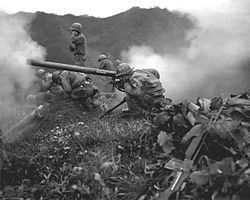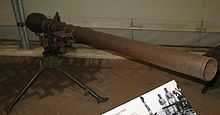M20 recoilless rifle

The M20 recoilless rifle was a U.S. 75 mm caliber recoilless rifle used during the last months of the Second World War and extensively during the Korean War. It could be fired from an M1917A1 .30 caliber machine gun tripod, or from a vehicle mount, typically a Jeep. Its shaped charge warhead, also known as HEAT, was capable of penetrating 100 mm of armor. Although the weapon proved ineffective against the T-34 tank during the Korean War, it was used primarily as a close infantry support weapon to engage all types of targets including infantry and lightly armored vehicles. The M20 proved useful against pillboxes and other types of field fortifications.
History

During World War II, the U.S. military recognized that, due to advancements in armor technology by enemy forces, a powerful lightweight weapon was needed to defend infantry and light armor units. The Ordnance Department Small Arms Division commenced development of a recoilless rifle and, by 1944, models of a 75 mm recoilless rifle were being tested. Production of the M20 was underway by March 1945; only limited numbers were used by Allied troops in the European and Pacific theaters.
The M20 relied on a perforated artillery shell casing, combined with a rear vented breech using propellant gases from the firing of a shell, to greatly reduce the recoil of the weapon. It is this use of vented propellant gases that eliminated the need for a recoil system, thereby reducing the weight of the launcher and enhancing its use as a light infantry weapon.
Recoilless rifles, such as the M20, were used successfully in large numbers by US forces during the Korean War; and by both sides in the First Indochina War (1946–54). They were phased out after being replaced by wire guided missiles, which were introduced during the Vietnam War in the 1960s and 1970s. Currently, M20 recoilless rifles are being used as part of the avalanche control system used by the U.S. National Forest Service and National Park Service. There are also pictures suggesting its use by guerrillas in the Lebanese Civil War.
Specifications
- Length: 6 ft 10 in (2.08 m)
- Weight: 114.5 lb (52 kg)
- Rifling: uniform right hand twist, 1 turn in 25
- Range: (HEAT) 7,000 yards (6.4 km)
- Muzzle velocity: (HEAT) 1,000 ft/s (300 m/s)
- Cartridge: 75 × 408 mm. R
- Caliber: 75 mm. (2.95 inches)
- Round weight:
- HE: 21.86 lb (9.92 kg)
- HEAT: 20.54 lb (9.32 kg)
- Smoke (T40, WP): 22.61 lb (10.26 kg)
- Armor penetration: 4 inches (100 mm)
See also
- M18 recoilless rifle – smaller caliber model of the same era
- M29 Weasel – the "M29C Type A" variant had a center mounted M20 as its armament
References
- TM 9-2300 Artillery Materiel and Associated Equipment. dated May 1949
- TM 9-314 operators, and maintenance
- SNL C-74 parts
External links
- The short film STAFF FILM REPORT 66-21A (1966) is available for free download at the Internet Archive